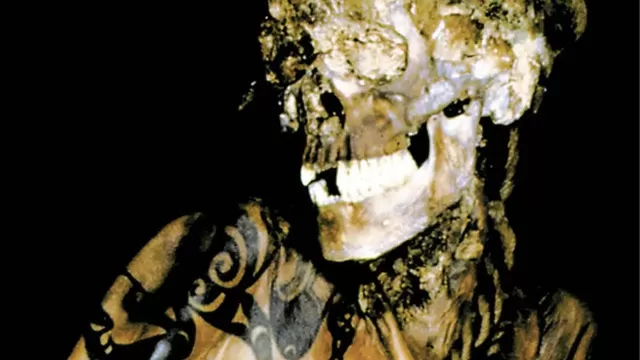In 1993, archaeologists made a discovery that changed our understanding of ancient cultures. On the remote Ukok Plateau in Siberia, the frozen remains of a Scytho-Siberian woman, later called the “Ice Maiden,” were unearthed. This incredible discovery revealed not only her well-preserved body, but also one of the oldest examples of tattooing in human history. What secrets does the Ice Maiden hold about the culture and beliefs of her time? Let’s dive into her extraordinary story.
The Discovery of the Ice Maiden
The story begins on the Ukok Plateau, near the borders of Russia, Mongolia, China and Kazakhstan. In 1993, Russian archaeologist Natalia Polosmak led an excavation team to this remote location, known for its harsh climate and permafrost. The site was a burial mound, or kurgan, that had been undisturbed for more than 2,600 years.

Inside, they discovered the remarkably preserved remains of a woman buried in a wooden coffin surrounded by intricate grave goods. The freezing conditions had protected her body, preserving her skin, hair and even her clothes. The find also included objects such as textiles, tools and six horses with saddles and bridles, hinting at her high social status.
This discovery is revolutionary, not only because of its preservation, but also because of the information it provides about the lives of the Pazyryk people, a nomadic group who inhabited the region during the early Iron Age.
Who was the ice girl?
The Ice Maiden is believed to have been a member of the Pazyryk culture, a nomadic Scythian group known for their artistic talent, horseback riding, and elaborate burial practices. Archaeologists speculate that she may have played an important role in their society, perhaps as a shaman or spiritual leader, given the absence of weapons in her grave and the inclusion of objects such as a dish of cannabis seeds.

Her grave goods also reflected her concern for her appearance and status. Among them was a makeup bag containing remnants of vivianite, a blue-green mineral used as eyeliner. Her elaborate clothing, including a silk blouse and wool skirt, suggested connections with faraway places like China, hinting at a strong trade network.

The Oldest Tattoos in History
One of the most fascinating aspects of the Ice Maiden was the discovery of intricate tattoos on her body. These are some of the oldest tattoos ever discovered and have been preserved in incredible detail thanks to the permafrost.
The tattoos depict fantastical creatures, including a stag with elongated antlers that transform into griffin heads. These designs were not only decorative, but had deep spiritual and cultural meaning. They likely represented protection, beauty, and guidance to the afterlife.

Dr. Polosmak suggested that tattoos were a sign of beauty for the Pazyryk people. The fact that they were placed on the shoulder, a visible and prominent area, underlines their importance in expressing identity and status.
Funerary practices of the Pazyryk people
The Pazyryk culture is renowned for its elaborate burial practices, and the Ice Maiden’s tomb is no exception. Her coffin was intricately carved and surrounded by objects meant to accompany her into the afterlife, including six horses symbolizing wealth and mobility.
Her clothing, which included a silk blouse, a striped wool skirt, and white felt leggings, demonstrated exquisite craftsmanship. The inclusion of silk, a rare material in Siberia, underscored the Pazyryk people’s connection to distant trade routes.

One of the most striking objects in his tomb was his three-foot-high headdress, decorated with gold and carved feline figures. These details suggest his important social role and spiritual importance within his community.
Scientific analysis and results
After her discovery, the Ice Maiden was taken to a laboratory for detailed scientific analysis. Radiocarbon dating confirmed that she lived approximately 2,500 years ago, during the early Iron Age. DNA analysis revealed that she was genetically related to modern-day Siberian indigenous populations, providing valuable insights into the ancestry and migration patterns of the Pazyryk people.

Forensic examinations have revealed more details about her life and death. The ice maiden likely died in her mid-20s and suffered from a serious illness, possibly breast cancer, in her final years. Cannabis seeds found in her grave suggest she may have used the plant for medicinal or spiritual purposes, perhaps to relieve pain or alter her consciousness during rituals.
Cultural and ethical controversies
The discovery of the ice maiden was not without controversy. The indigenous people of Altai, who consider the Ukok Plateau a sacred site, protested the removal of her remains. They believe that the ice maiden was the spiritual guardian of the region and that disturbing her burial caused natural disasters and misfortune.
The Ice Maiden has also become a symbol of the Altai region’s autonomy from the Russian Federation. Local activists have used her story as a metaphor for the struggle of indigenous communities to protect their heritage and identity.
In 2012, his remains were returned to the Altai Republic and placed in a specially designed museum. However, many locals continue to demand his reburial, citing cultural and spiritual reasons.
Today, the Ice Maiden is a symbol of Siberia’s rich archaeological heritage. Her discovery has sparked new research into the Pazyryk culture and its connections to other ancient civilizations. Tattoos, burial practices, and artifacts found alongside her have shed light on a sophisticated nomadic society that thrived more than 2,500 years ago.
His legacy also extends to modern cultural discussions, emphasizing the importance of respecting Indigenous beliefs while advancing archaeological research.
The 2,600-year-old Ice Maiden is a testament to the art, spirituality, and complexity of the Pazyryk people. Her tattoos, among the oldest ever discovered, reveal a culture that placed great importance on identity and symbolism, closely tied to its beliefs about the afterlife. While her story raises ethical questions about the treatment of ancient remains, it also offers an unprecedented glimpse into a world long gone but not forgotten. The Ice Maiden remains an enduring symbol of resilience, art, and the mysteries of the past.





